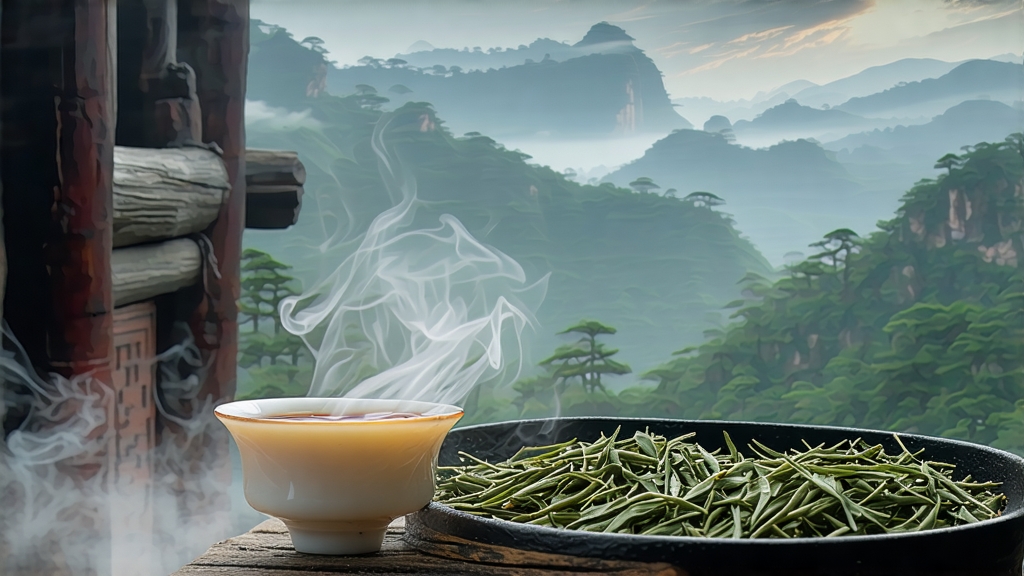
Lapsang Souchong, known in China as Zheng Shan Xiao Zhong, is the earliest black tea ever created and the progenitor of every red-black tea that followed. Its birthplace is the Wuyi Mountain range in northern Fujian, a UNESCO biosphere reserve where sheer cliffs, mineral-rich soils, and a perpetual veil of mist nurture the small-leaf tea cultivars that give this tea its singular character. International drinkers often encounter two versions: the traditional pine-smoked original and the newer, unsmoked “wild” style. Both spring from the same protected micro-region—Tongmu Guan—but diverge in the final stage of firing, producing liquors that can recall campfire whiskey or dried longan and honey.
Historical records trace Lapsang Souchong to the late Ming dynasty, around 1604, when passing armies forced villagers to speed-dry freshly picked leaves over available pine fires so the crop would not spoil. The accidental smoke infusion delighted the first Dutch merchants who carried it to Europe, where it became the “bohea” that filled the cups of London coffeehouses and sparked the Boston Tea Party. For two centuries Tongmu Guan remained a closed valley; outsiders were barred on pain of death so the imperial court could monopolize the technique. Even today entry requires a special permit, and only a handful of families descended from the original smoke-masters are licensed to produce the authentic grade.
The tea belongs to the Camellia sinensis var. sinensis species, characterized by diminutive leaves that tolerate slow withering without losing delicacy. Picking takes place only between Qingming and the summer solstice; two leaves and a bud are plucked when the morning dew has just lifted. Once in the workshop the leaves undergo six meticulous steps: sun-withering, indoor withering on bamboo trays, rolling on rattan mats to bruise cell walls, enzymatic oxidation in wooden chests, a hot wok “sha qing” arrest at 200 °C, and finally the iconic pinewood smoke-drying. For the traditional style, producers build a raised oven called a qinglou. Freshly oxidized leaves are spread on bamboo sieves stacked above a smoldering fire of resinous Masson pine and local Chinese red pine; the smoke must be cool enough to avoid scorching yet rich in aromatic terpenes. Over eight hours the leaves absorb guaiacol and syringol compounds that translate into the tea’s signature campfire sweetness. The unsmoked modern style skips the qinglou, instead baking the leaves in electric ovens calibrated to mimic the gentle heat while preserving the cultivar’s natural fruit and floral notes.
Terroir stamps every sip. The Wuyi’s rocky “danxia” landform weathers into sandy, slightly alkaline soil loaded with potassium and magnesium, minerals that thicken liquor body and create a lingering sweet aftertune locals call “yan yun”—rock rhyme. Cool canyon air slows photosynthesis, boosting amino acids and fragrant nerolidol, while diurnal swings of 15 °C lock in complex sugars. The result is a tea that can age gracefully for decades, its smoky edge mellowing into dried apricot and sandalwood.
To brew Lapsang Souchong gongfu style, start with 5 g of leaf in a 120 ml porcelain gaiwan. Rinse once with 95 °C water to awaken the leaves, then steep for 5 s, 10 s, 15 s, adding 5 s each subsequent infusion. The first cup releases a curling plume of pine and wintergreen; by the third, cocoa and ripe lychee emerge; the eighth often tastes of candied rose and mineral spring water. Western drinkers may use 2.5 g per 250 ml mug and infuse 3 min at 90 °C, but longer contact amplifies smoke to the point of masking subtle sweetness. Pair the traditional smoked version with dark chocolate or aged Gouda; the unsmoked style complements roasted duck or a buttery madeleine.
Professional cupping follows ISO 3103 standards: 2 g of leaf per 100 ml, 5 min at 100 °C. Evaluate dry-leaf aroma for resinous snap and absence of tar; liquor should glow amber-red, not murky brown. Slurp vigorously to aerosolize volatile compounds; a top-grade Lapsang Souchong presents a tri-layered profile—top pine and citrus, mid-palate